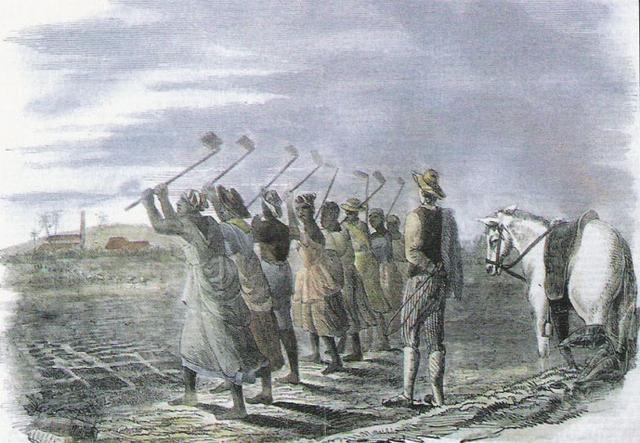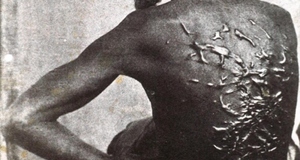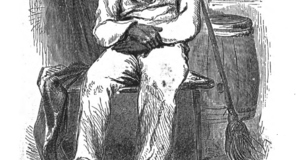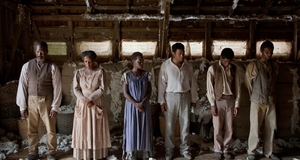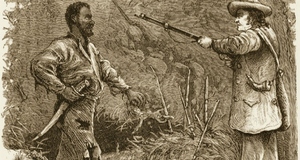Featured Article:Infanticide as Slave Resistance: Evidence from Barbados, Jamaica, and Saint-Domingue
By
2014, Vol. 6 No. 04 | pg. 2/2 | « Just as maternal tenderness and infanticide were not mutually exclusive, neither were altruism and subversion. In other words, it is extremely likely that mothers who committed infanticide did so with the duel intentions of saving their children from slavery and resisting slaveholding hegemony. To enter this discussion requires a preliminary understanding of resistance theory. Historians and anthropologists of slavery (as well as scholars in other fields) have in recent decades produced an abundance scholarship on what is often called ‘everyday resistance.’ Theorizers of everyday resistance point out that resistance need not occur within the context of organized political movements or involve violence.28 Everyday forms of slave resistance, unlike armed rebellion, were generally non-violent and included acts such as feigning illness to get off work.29 Scholarly treatment of everyday (sometimes termed ‘passive’ or ‘peaceful’) slave resistance dates at least as far back as 1942, with the publication of Raymond and Alice Bauer’s article “Day to Day Resistance to Slavery” in the Journal of Negro History. The Bauers cite self-mutilation, the destruction of plantation property, and the deliberate slowing down of work as examples of slave resistance in the antebellum American South.30 In a discussion of the French West Indies (including Saint-Domingue), Clarence Mumford explores the role of African-based dance rituals in slave resistance and posits that slaves’ participating in such rituals was a form of ‘passive’ resistance.31 The concept of everyday resistance compels us to consider the subversive nature of acts that may not initially appear particularly subversive.
Infanticide was an expression of enslaved women’s claim to their own children. Slave women who committed infanticide resisted slaveholder hegemony by laying claim to their own children over the master’s claim. Like suicide, slave infanticide was both tragic and imbued with subversive meanings. Scholars place infanticide under the heading ‘gynecological resistance,’ which refers to slave women’s attempts to resist reproduction through, for example, contraception and abortion.35 The most obvious component of infanticide as resistance is that by killing their infants, enslaved women denied slave owners the bodies that slavery required to function.36 Indeed, it is very likely that Caribbean planters, like those in the United States, saw slave infanticide as a form of robbery—robbery of their corporal capital. Records from the United States show that women who killed or threatened to kill their children recognized this and thus understood infanticide as a means of subversion.37 It is worth noting that the rape of female slaves by white masters and overseers is well-documented in both the British and French West Indies.38 There also exist records of slaves being forced to mate (or, in planters’ words, ‘breed’) to produce offspring.39 Infanticide of the children resulting from these nonconsensual sex acts bears special symbolic significance as an act of striking out against white male sexual predation.40 On an even more symbolic level, infanticide was an expression of enslaved women’s claim to their own children. As an institution, slavery was characterized by its displacement of kinship ties. As Christopher Peterson explains in an article on Toni Morrison’s Beloved, “Alienated from all rights or claims of birth, slaves are severed from all genealogical ties to their living blood relatives, and to their ancestors and descendants.”41 Under slavery, one could not make legal decisions regarding one’s children. Slavery undermined a parent’s ability to determine how her children should live and where they should live. Slaveholders’ legal ownership of enslaved bodies trumped parents’ natural rights of guardianship. Slave women who committed infanticide thus resisted slaveholder hegemony by laying claim to their own children over the master’s claim.42 All of this is not to suggest every act of infanticide in Barbados, Jamaica, and Saint-Domingue was an act of resistance or that all women who committed infanticide had a subversive aim. To imply that this was the case would not only be overly simplistic, but might also reinforce negative stereotypes about the malevolent, evil slave mother. On the contrary, it is not unlikely that many slave women who killed their children did so for supremely altruistic reasons. It is also quite possible that individual cases of infanticide resulted from a combination of both insurrectionary and altruistic aims, not merely one or the other. Indeed, resistance and altruism are not mutually exclusive; slave women who killed their children might have done so with the dual intentions of resisting slaveholder authority and protecting their children. It is highly unlikely that slave women who killed their children approached it uniformly— for some, it was probably a deeply sad affair, for others, an emotionally neutral one; for some, an act of resistance against slavery, for others, an act of altruism toward their offspring. For others still, it may have been a combination of all of these things. The point is that to only conceive of slave infanticide as an act of tragic motherly love, or to disregard its insurrectionary undertones, leaves one with an incomplete understanding of it. To paraphrase Haitian historian Michel Trouillot, the story of Caribbean slave women—a story of which infanticide is a part— is filled with silences.43 Further research on slave infanticide in the Caribbean is needed. Attempting to understand why some enslaved women in Jamaica, Barbados, and Saint-Domingue committed infanticide helps fill some of these silences and tell a more complete story. It may seem presumptuous for contemporary writers to take on the role of storyteller of a story that is not theirs. This is a valid criticism. At the very least, it underscores the necessity of not filling the holes left by historical silences with our own preconceptions; of coaxing silenced voices out of the records, not creating new ones. To disregard the potential of slave infanticide as an act of rebellion is to disregard slave women’s agency as dissidents under a system that worked to silence, dehumanize, and disempower them. The Saint-Domingue midwife who killed so many infants, Sabina Park of Jamaica, the Saint-Domingue woman who wanted to “steal” her children from slavery: these women’s stories suggest a clear insurrectionary motivation behind their actions. Writers of history owe them, and women like them, recognition as agents of resistance. ReferencesBauer, Raymond A. and Alice H. Bauer. “Day to Day Resistance to Slavery.” In Rebellions, Resistance, and Runaways Within the Slave South, edited by Paul Finkelman, 84-115. New York and London: Garland Publishing, Inc., 1989. Originally published in Journal of Negro History 27 (1942): 388-419. Beckles, Hilary McD. Natural Rebels: A Social History of Enslaved Black Women in Barbados. Rutgers, NJ: Rutgers University Press, 1989. Brown, Vincent. “Spiritual Terror and Sacred Authority in Jamaican Slave Society.” Slavery and Abolition 24 (2003): 24-53. Burnurd, Trevor. “The Sexual Life of an Eighteenth-Century Jamaican Slave Overseer.” In Sex and Sexuality in Early America, edited by Merril D. Smith, 163-189. New York: New York University Press, 1998. Bush, Barbara. “Defiance or submission? The role of the slave woman in slave resistance in the British Caribbean.” Immigrants and Minorities 1 (1989): 16-38. ---. Slave Women in Caribbean Society: 1650-1838. Bloomington, Indiana: Indiana University Press, 1990. Bush-Slimani, Barbara. “Hard Labour: Women, Childbirth and Resistance in British Caribbean Slave Societies.” In More Than Chattel: Black Women and Slavery in the Americas, edited by David Barry Gaspar and Darlene Clark Hine, 193-217. Bloomington and Indianapolis: Indiana University Press, 1996. Camp, Stephanie M.H. Closer to Freedom: Enslaved Women and Everyday Resistance in the Plantation South. Chapel Hill: University of North Carolina Press, 2004. Christian, Barbara. “Beloved, She’s Ours.” Narrative 5 (1997): 36-49. Compton, Tonia M. “Infanticide.” In Encyclopedia of Slave Resistance and Rebellion, Volume 1: A-N, edited by Junnius P. Rodriguez, 259-263. Westport, CT and London: Greenwood Press 2007. Delle, James A. “Women’s Lives and Labour on Radnor, a Jamaican Coffee Plantation, 1822-1826.” Caribbean Quarterly 54 (2008): 7-23. Dunn, Richard S. “The Demographic Contrast between Slave Life in Jamaica and Virginia, 1760–1865.” Proceedings of the American Philosophical Society 151 (7007): 43-60. Fox-Genovese, “Strategies and Forms of Resistance: Focus on Slave Women in the United States.” In In Resistance: Studies in African, Caribbean, and Afro-American History, ed. Gary Y. Okihiro, 143-165. Amherst: University of Massachusetts Press, 1986. Hine, Diane Clark and Kathleen Thompson. A Shining Thread of Hope: The History of Black Women in America. New York: Broadway Books, 1998. Inniss, Tara A. “‘Any Elderly, Sensible, Prudent Woman’: The Practice and Practitioners of Midwifery During Slavery in the British Caribbean,” in Health and Medicine in the Circum Caribbean, 1800-1968. Edited by Juanita De Barros, Steven Palmer and David Wright, 40-52. New York: Routledge, 2009. McClellan, James E. Colonialism and Science: Saint Domingue and the Old Regime (Chicago: University of Chicago Press, 1992. Morgan, Kenneth. “The Struggle for Survival: Slave Infant Mortality in the British Caribbean in the Late Eighteenth and Nineteenth Centuries.” In Children in Slavery Through the Ages, edited by Gwyn Campbell, Suzanne Miers, and Joseph C. Miller, 187-203. Athens, Ohio: Ohio University Press, 2009. Mumford, Clarence J. The Black Ordeal of Slavery and Slave Trading in the French West Indies, 1625-1715, Volume III: Culture, Terror, Resistance. Lampeter, UK, Queenstown, ON, and Lewiston, NY: Edwin Mellen Press, 1991. Patterson, Orlando. The Sociology of Slavery: An Analysis of the Origins, Development and Structure of Negro Slave Society in Jamaica. Cranbury, NJ: Associated University Presses, Inc., 1969. Peterson, Christopher. “Beloved’s Claim.” Modern Fiction Studies 52 (2006): 548-569. Popkin, Jeremy D. You Are All free: The Haitian Revolution and the Abolition of Slavery. New York: Cambridge University Press, 2010. Schiebinger, Londa L. Plants and Empire: Colonial Bioprospecting in the Atlantic World. Cambridge, Harvard University Press, 2007. Trouillot, Michel-Rolph. Silencing the Past: Power and the Production of History. Boston: Beacon Press, 1995. Turiel, Elliot. “Resistance and Subversion in Everyday Life.” Journal of Moral Education 32 (2003): 115-130. Weaver, Karol K. “‘She Crushed the Child’s Fragile Skull’: Disease, Infanticide, and Enslaved Women in Eighteenth-Century Saint-Domingue.” French Colonial History 5 (2004): 93-109. White, Deborah Gray. Ar’n’t I a Woman? Female Slaves in the Plantation South. New York and London: W.W. Norton and Company, 1985. Endnotes1.) Kenneth Morgan, “The Struggle for Survival: Slave Infant Mortality in the British Caribbean in the Late Eighteenth and Nineteenth Centuries,” in Children in Slavery Through the Ages, eds. Gwyn Campbell, Suzanne Miers, and Joseph C. Miller, 187-203 (Athens, Ohio: Ohio University Press, 2009), 189, 191. 2.) Barbara Bush-Slimani, “Hard Labour: Women, Childbirth and Resistance in British Caribbean Slave Societies,” in More Than Chattel: Black Women and Slavery in the Americas, eds. David Barry Gaspar and Darlene Clark Hine (Bloomington and Indianapolis: Indiana University Press, 1996), 209. 3.) Orlando Patterson, The Sociology of Slavery: An Analysis of the Origins, Development and Structure of Negro Slave Society in Jamaica (Cranbury, NJ: Associated University Presses, Inc., 1969), 106. 4.) Christopher Peterson, “Beloved’s Claim,” Modern Fiction Studies 52 (2006), 553-554. 5.) The choice of these three colonies was made purely out of necessity, as accounts of slave infanticide in other parts of the Caribbean are extremely hard to come by. 6.) Barbara Bush, Slave Women in Caribbean Society: 1650-1838 (Bloomington, Indiana: Indiana University Press, 1990), 139-140. Although many slave women did have abortions, it is difficult to tell from the extant sources how many supposedly induced abortions were actually miscarriages. 7.) Bush-Slimani, “Hard Labour,” 202. 8.) Karol K. Weaver, “‘She Crushed the Child’s Fragile Skull’: Disease, Infanticide, and Enslaved Women in Colonial St. Domingue,” French Colonial History 4 (2004), 93-96. 9.) Weaver, “‘She Crushed the Child’s Fragile Skull,’” 101, 102. 10.) Weaver, “‘She Crushed the Child’s Fragile Skull,’” 104. 11.) Hilary McD. Beckles, Natural Rebels: A Social History of Enslaved Black Women in Barbados (Rutgers, NJ: Rutgers University Press), 159. 12.) Tara A. Inniss, “‘Any Elderly, Sensible, Prudent Woman’: The Practice and Practitioners of Midwifery During Slavery in the British Caribbean,” in Health and Medicine in the Circum Caribbean, 1800-1968, eds. Juanita De Barros, Steven Palmer and David Wright (New York: Routledge, 2009), 44. 13.) Bush-Slimani, “Hard Labour,” 209. 14.) James A. Delle, “Women’s Lives and Labour on Radnor, a Jamaican Coffee Plantation, 1822-1826,” Caribbean Quarterly 54 (2008), 17. 15.) Bush-Slimani, “Hard Labour,” 209. By “responses of slave women to their bondage,” Bush is referring to abortion and birth control as well as infanticide. 16.) Bush-Slimani, “Hard Labour,” 208. 17.) Morgan, “The Struggle for Survival,” 189; Bush, Slave Women, 148; Bush-Slimani, “Hard Labour,” 207-208. 18.) Bush-Slimani, “Hard Labour,” 209. 19.) For example, Jeremy D. Popkin, You Are All free: The Haitian Revolution and the Abolition of Slavery (New York: Cambridge University Press, 2010), 28; James E. McClellan, Colonialism and Science: Saint Domingue and the Old Regime (Chicago: University of Chicago Press, 1992), 52; 20.) Londa L. Schiebinger, Plants and Empire: Colonial Bioprospecting in the Atlantic World (Cambridge, Harvard University Press, 2007), 146. 21.) Schiebinger, Plants and Empire, 146. 22.) Schiebinger, Plants and Empire, 146. Although the midwife in question killed other women’s, not her own, infants, she probably did so with consent from the mothers. Killing infants carried with it a huge risk; to do so against a mother’s wishes would have meant certain punishment. 23.) Richard S. Dunn, “The Demographic Contrast between Slave Life in Jamaica and Virginia, 1760–1865,” Proceedings of the American Philosophical Society 151 (2007), 51. 24.) Darlene Clark Hine and Kathleen Thompson, A Shining Thread of Hope: The History of Black Women in America (New York: Broadway Books, 1998), 99. Indeed, according to Darlene Clark Hine and Kathleen Thompson on slave infanticide, “it is important to note that the relatively small number of documented cases is not as significant as the fact that it occurred at all.” 25.) For example, Deborah Gray White, Ar’n’t I a Woman? Female Slaves in the Plantation South (New York and London: W.W. Norton and Company, 1985), 87-89. 26.) For example, White, Ar’n’t I a Woman?, 88. According to White, “These cases present atypical behavior on the part of slave mothers. Runaway and truancy data suggest mothers cared dearly for their children.” Similarly, according to Eugene Genovese after mentioning infanticide, slaves “loved their children too much to do away with them.” Eugene D. Genovese, Roll, Jordan, Roll: The World the Slaves Made (New York: Pantheon Books, 1972, 1974) 197. 27.) Hine and Thompson, A Shining Thread of Hope, 100-01. This statement is a direct response to Genovese. 28.) See Elliot Turiel, “Resistance and Subversion in Everyday Life,” Journal of Moral Education 32 (2003), 116. 29.) Stephanie M.H. Camp, Closer to Freedom: Enslaved Women and Everyday Resistance in the Plantation South (Chapel Hill: University of North Carolina Press, 2004), 2. 30.) Raymond A. Bauer and Alice H. Bauer, “Day to Day Resistance to Slavery,” in Rebellions, Resistance, and Runaways Within the Slave South, ed. Paul Finkelman (New York and London: Garland Publishing, Inc., 1989), 86, 416-17. The Bauers also cite slave infanticide as a possible form of everyday resistance, but conclude that there is not enough evidence to make any definitive statements. 31.) Clarence J. Mumford, The Black Ordeal of Slavery and Slave Trading in the French West Indies, 1625-1715, Volume III: Culture, Terror, Resistance (Lampeter, UK, Queenstown, ON, and Lewiston, NY: Edwin Mellen Press, 1991), 887. 32.) Vincent Brown, “Spiritual Terror and Sacred Authority in Jamaican Slave Society,” Slavery and Abolition 24 (2003), 25. 33.) Vincent Brown, “Spiritual Terror and Sacred Authority,” 24-53. 34.) Brown, “Spiritual Terror and Sacred Authority,” 25, and Barbara Bush, “Defiance or submission? The Role of the Slave Woman in Slave Resistance in the British Caribbean,” Immigrants and Minorities 1 (1989), 18. According to Bush, “suicides were not simply evidence of apathy and despair but, according to West African religious belief, a positive means of attaining freedom.” 35.) Tonia M. Compton, “Infanticide,” in Encyclopedia of Slave Resistance and Rebellion, Volume 1: A-N, ed. Junnius P. Rodriguez (Westport, CT and London: Greenwood Press, 2007), 259. 36.) This would have been particularly pertinent after the abolition of the British slave trade in 1807, which forced planters to maintain their slave populations through reproduction rather than by importing new slaves. 37.) Compton, “Infanticide,” 261. 38.) Mumford, The Black Ordeal of Slavery and Slave Trading, 853-857; Trevor Burnurd, “The Sexual Life of an Eighteenth-Century Jamaican Slave Overseer,” in Sex and Sexuality in Early America, ed. Merril D. Smith (New York: New York University Press, 1998), 163-189; Bush-Slimani, “Hard Labour,” 194-95. 39.) Mumford, The Black Ordeal of Slavery and Slave Trading, 852. 40.) Barbara Christian, “Beloved, She’s Ours,” Narrative 5 (1997), 41-42; Elizabeth Fox-Genovese, “Strategies and Forms of Resistance: Focus on Slave Women in the United States,” in In Resistance: Studies in African, Caribbean, and Afro-American History, ed. Gary Y. Okihiro (Amherst: University of Massachusetts Press, 1986), 158. Fox-Genovese claims that there is not enough evidence to claim that this was a common occurrence, but that she would consider it a form of resistance if and when it did happen. 41.) Peterson, “Beloved’s Claim,” 549. 42.) The ideas presented in this paragraph are borrowed heavily from Peterson, “Beloved’s Claim,” 554. 43.) Michel-Rolph Trouillot, Silencing the Past: Power and the Production of History (Boston: Beacon Press, 1995). Suggested Reading from Inquiries Journal
Inquiries Journal provides undergraduate and graduate students around the world a platform for the wide dissemination of academic work over a range of core disciplines. Representing the work of students from hundreds of institutions around the globe, Inquiries Journal's large database of academic articles is completely free. Learn more | Blog | Submit Latest in History |

